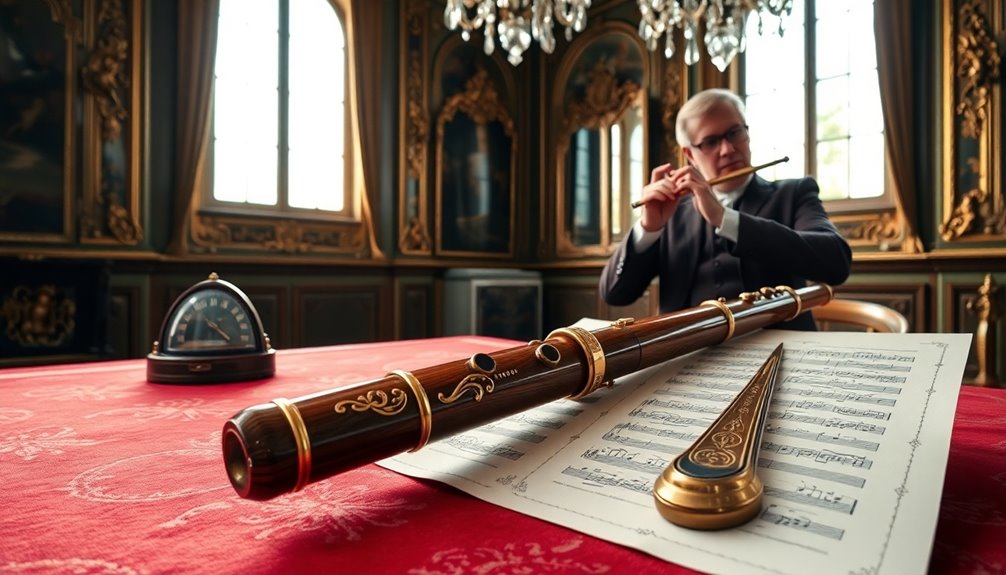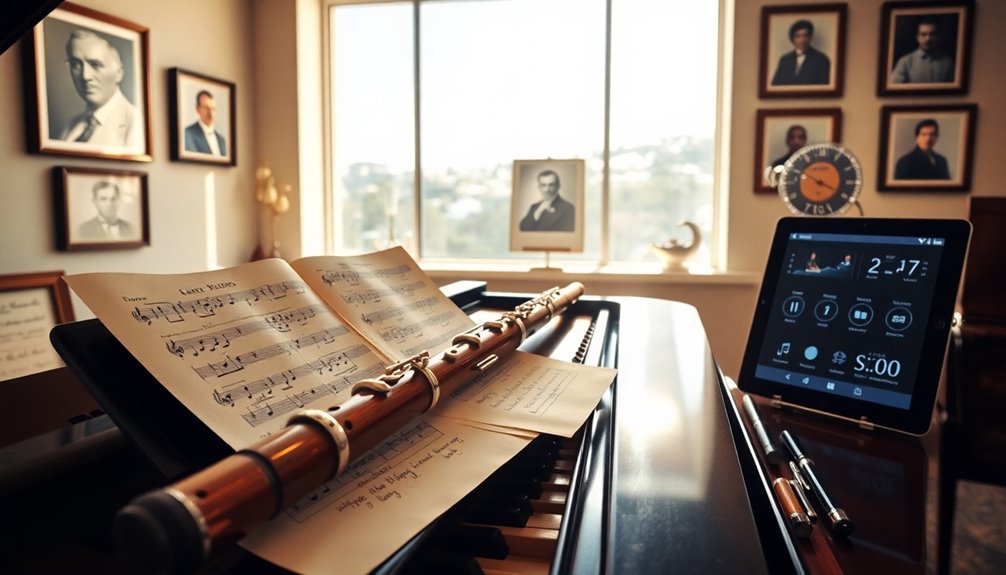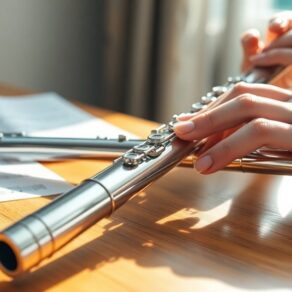Throughout history, effective flute practice routines have considerably transformed. In ancient cultures, breath control was foundational for sound production. The Baroque period emphasized expressiveness and ornamentation, while the Classical era introduced structured forms and clarity. During the Romantic period, individual expression became paramount, driven by composers like Doppler. The 20th century saw systematic techniques that enhanced proficiency, and modern practices integrate traditional skills with technological advances. Influential masters from various backgrounds enriched the repertoire and techniques. Understanding these historical contexts provides deeper insight into the evolution of flute practice, guiding you toward more effective routines today.
Key Takeaways
- Ancient cultures emphasized breath control as a foundational technique, shaping early flute practice routines and sound production.
- Baroque musicians focused on expressiveness and ornamentation, incorporating specific exercises to enhance musical phrasing and emotional depth.
- Classical flutists adopted structured forms, practicing clarity and thematic development, influenced by composers like Mozart and Haydn.
- Romantic era flutists explored individual emotional expression, expanding practice routines to include interpretative exercises and diverse repertoire.
- 20th-century advancements introduced systematic techniques, promoting consistent practice routines and resources to enhance technical proficiency and artistry.
Ancient Flute Practices

How did ancient cultures shape the flute practices we comprehend today? The flute, with its rich history, reflects the evolution of music and culture across civilizations. In ancient times, various cultures developed unique techniques for creating and playing flutes, each contributing to the diverse soundscapes we appreciate now.
You can see this influence in the historical flutes carved from materials like wood, bone, and even metal, each choice reflecting the resources and aesthetics of the society. For instance, the ancient Egyptians crafted flutes from reeds, utilizing their natural environment, while the Chinese dizi showcased intricate craftsmanship, influencing not just local traditions but also inspiring neighboring regions.
These ancient techniques laid the foundation for flute construction and playing methods. The concept of breath control, which is essential in modern flute practice, was present in these early cultures, emphasizing the importance of the musician's physicality in producing sound. In fact, the concert flute has roots in these earlier designs, showcasing its evolution over centuries.
As you explore the study of ancient flute practices, you'll discover how these societies viewed music not merely as entertainment but as a significant part of spiritual and communal life. By grasping these historical contexts, you'll gain a deeper appreciation for the flute and its evolution.
Embracing the wisdom of ancient flutists can enhance your own practice, connecting you to a lineage of musicians who've shaped the art form, reminding you that your journey, however contemporary, is intertwined with this rich tapestry of human expression.
The Baroque Period Techniques

During the Baroque period, which spanned from approximately 1600 to 1750, flutists adopted a range of innovative techniques that considerably shaped the instrument's repertoire and performance practices.
This era emphasized expressiveness and ornamentation, allowing you to explore your artistic identity through intricate musical phrases. Mastering these techniques requires dedication and attention to breath control, which serves as the foundation for executing elaborate embellishments.
Here are three key ornamental techniques you should focus on during your practice:
- Trills: These rapid alternations between adjacent notes create a vibrant, lively effect. Practicing trills can enhance your dexterity and add sophistication to your playing.
- Turns: Incorporating turns—quick sequences of notes around a central pitch—can enrich your musical lines, allowing for greater emotional expression. Spend time perfecting these subtle flourishes to elevate your performances.
- Mordents: These short, quick ornaments involve a rapid alternation between a note and its lower or upper neighbor. They require precise breath control and finger coordination to execute cleanly.
As you investigate these techniques, remember that your breath control plays an essential role in how effectively you can execute them. Practicing long tones will not only improve your ornamentation but also enhance your overall musicianship. Embrace the Baroque period's artistic ethos, and you'll find a deeper connection to the music you love.
Your journey through these techniques will shape your identity as a flutist, fostering a sense of belonging within the rich tradition of flute playing.
Classical Era Approaches

Building on the ornamentation techniques of the Baroque period, the Classical Era introduced a shift in focus towards clarity, balance, and the development of thematic material. As you explore this period, you'll notice how composers like Mozart and Haydn emphasized structured forms and expressive melodies, which provided flutists with new frameworks for practice.
Incorporating Mozart's techniques, such as clean articulation and dynamic contrasts, can enhance your performance. Similarly, Haydn's compositions often featured playful motifs and conversational exchanges, encouraging you to investigate different tonal colors and character in your playing. Additionally, understanding the importance of structured progressions in your practice can help you develop a solid foundation.
Here's a concise overview of important aspects of Classical Era flute practice:
| Aspect | Mozart's Techniques | Haydn's Compositions |
|---|---|---|
| Clarity of Melody | Focus on lyrical phrasing | Use of humor and wit |
| Articulation | Emphasis on staccato and legato | Varied articulation styles |
| Dynamics | Strong contrasts and nuances | Subtle dynamic shifts |
| Thematic Development | Use of recurring motifs | Experiments with form |
| Characterization | Expressive and dramatic | Playful and light-hearted |
Romantic Period Innovations

Embracing emotional expression and individualism, the Romantic Period marked a significant evolution in flute practice, inviting musicians to explore deeper interpretative possibilities. This era shifted focus from technical precision to the pursuit of romantic expressiveness, enhancing the flute repertoire with new works that challenged players' emotional and technical capacities.
During this time, you'll notice three key innovations in flute practice:
- Expanded Repertoire: Composers like Franz Doppler and Paul Taffanel introduced pieces that demanded greater emotional depth and technical skill, allowing you to express a broader range of feelings through your playing.
- Improvised Ornamentation: Musicians were encouraged to add personal touches to melodies, fostering a sense of individuality in performances. This practice not only enhanced expressiveness but also strengthened your connection with the music, allowing you to convey your unique interpretation.
- Focus on Tone Quality: With an emphasis on rich, warm tones, the Romantic Period urged flutists to prioritize sound quality over sheer volume. This shift encouraged you to explore various timbres and colors, enhancing your overall musicianship.
Through these innovations, the Romantic Period transformed flute practice into an art form grounded in emotion and personal expression. Additionally, the exploration of traditional flute melodies during this period served as a vital source of inspiration for musicians seeking to connect deeply with their cultural roots.
20th Century Methodologies

The innovations of the Romantic Period laid the groundwork for 20th-century methodologies, which further revolutionized flute practice through a focus on technique and pedagogical advancements. As you explore these methodologies, you'll notice a significant shift from the rudimentary practice materials of the 16th century to more structured and detailed resources. This evolution reflects a growing understanding of the importance of targeted practice.
In the early 20th century, the emphasis on technical proficiency became paramount. Flutists began to adopt systematic approaches that encouraged consistent practice routines. You'd find methods like Taffanel and Gaubert's works, which provided etudes designed to refine both technique and musicality. These materials not only served as practice tools but also as a means of cultivating a sense of community among flutists. They established shared standards and expectations that fostered collective growth.
Moreover, the advent of recorded music during this period allowed you to analyze and emulate professional performances in ways previously unavailable. You could listen to renowned flutists, studying their interpretations and technical nuances, which further enriched your practice experience.
Ultimately, 20th-century methodologies encouraged a more individualized approach to practice. You were now equipped with a variety of resources that allowed you to tailor your routines according to your specific needs and goals. This era marked a pivotal moment in flute pedagogy, emphasizing that effective practice isn't just about repetition but also about informed, reflective engagement with the instrument. Additionally, the integration of advanced techniques into practice routines allowed flutists to explore new artistic possibilities and enhance their overall performance quality.
Modern Flute Techniques

Modern flute techniques have evolved considerably, integrating diverse influences from various musical genres and pedagogical philosophies. As you explore these techniques, you'll find that they emphasize essential skills necessary for expressive performance. Here are three key areas to focus on:
- Breath Control: Mastering breath control is fundamental. It enhances tone production, allowing you to achieve a rich, vibrant sound. You'll learn to regulate your airflow, which is critical for dynamic expression.
- Finger Agility: Developing finger agility is crucial for technical proficiency. Engaging in articulation exercises and scale proficiency routines will sharpen your dexterity, enabling you to execute rapid passages with ease.
- Vibrato Techniques: Incorporating various vibrato techniques adds depth to your sound. Experiment with different speeds and widths to discover what resonates best with your style.
By practicing these elements, you not only improve your overall performance but also deepen your connection to the music. Additionally, focusing on breath control techniques can significantly enhance your endurance and overall sound quality.
Extended techniques, such as multiphonics or flutter-tonguing, may further enhance your repertoire and creativity. These contemporary approaches invite you to push boundaries while fostering a sense of belonging within diverse musical communities.
Incorporating these modern flute techniques into your practice routine will empower you to express yourself fully. Embrace the journey, as each practice session brings you closer to mastering the instrument and connecting with others who share your passion for the flute.
Influential Flute Masters

Throughout history, flute masters have shaped the instrument's evolution and enriched its repertoire, influencing generations of musicians. You might consider how Japanese masters, with their deep-rooted traditions, have contributed to the meditative qualities of flute music, integrating mindfulness into practice. Their techniques often emphasize breath control, a principle that resonates across cultures.
Meanwhile, French virtuosos have pushed the boundaries of technical skill and expression. Their innovative approaches to articulation and tone color have inspired countless flutists to explore new domains of sound. You can see their impact in the works of composers who sought to mimic the fluidity and grace of the flute, forming a bridge between classical and modern aesthetics.
In the United States, American pioneers embraced this legacy, blending diverse musical influences to create a unique voice. They experimented with jazz and folk elements, encouraging you to explore improvisation and personal expression in your practice.
On the other hand, Russian composers infused their works with dramatic intensity, challenging flutists to convey deep emotional narratives. Their compositions often require a robust technical foundation, urging you to develop both strength and sensitivity in your playing.
Spanish influences, rich in rhythm and flair, have also contributed notably to flute repertoire, inviting you to engage with vibrant, passionate music.
Finally, contemporary innovators continue to redefine what the flute can do, merging classical technique with modern genres. These modern composers often incorporate extended techniques that challenge traditional flute playing and expand its expressive range. By studying these masters and their diverse contributions, you'll find inspiration that can elevate your practice and deepen your connection to this beautiful instrument.
Future of Flute Practice

As the landscape of music continues to evolve, the future of flute practice is poised to embrace a blend of tradition and innovation. With the rise of technology, you'll find that practicing the flute will be more accessible and personalized than ever before.
Here are three key trends shaping this future:
- Digital Resources: You'll have access to a wealth of digital resources, including sheet music, play-along tracks, and practice apps that can enhance your skills.
- Online Tutorials and Virtual Lessons: These platforms allow for flexible learning. You can choose from countless online tutorials, or engage in virtual lessons with renowned instructors from around the world, receiving personalized feedback tailored to your unique needs.
- Collaborative Practice and Community Engagement: Embracing technology integration, you can connect with fellow flutists through online forums, social media groups, and collaborative practice sessions. This fosters a sense of belonging and support in your musical journey.
As adaptive learning techniques become more prevalent, your practice will evolve to meet your individual learning style. Additionally, the availability of affordable options ensures that aspiring flutists from all backgrounds can engage with these innovative resources.
You'll find that the combination of traditional techniques with modern technology not only enhances your skills but also deepens your connection to the musical community. The future of flute practice is bright and full of possibilities, inviting you to explore new paths and embrace the journey ahead.
Frequently Asked Questions
How Do Cultural Differences Influence Flute Practice Across Regions?
Cultural differences greatly influence how you approach flute practice.
In Eastern techniques, you might focus on breath control and expression, deeply rooted in cultural significance.
Meanwhile, Western traditions often emphasize technical precision and performance standards.
Regional styles vary, with each area fostering unique practices and interpretations.
What Role Does Technology Play in Modern Flute Practice?
In a world where silence meets symphony, technology reshapes your flute practice. Digital tools and online resources provide instant access to tutorials and expert feedback, transforming isolation into community.
You can connect with fellow musicians across the globe, sharing insights and experiences. Yet, this reliance on screens risks overshadowing the intimate connection with your instrument.
Balancing these innovations with traditional methods can deepen your practice, fostering both personal growth and collective belonging.
Are There Significant Differences in Flute Materials Used Historically?
Yes, there're significant differences in flute materials used historically.
You'll find that wooden flutes dominated earlier periods, offering a warm, rich tone, while metal flutes emerged later, providing a brighter, more focused sound.
The shift reflects changes in musical styles and preferences.
Understanding these materials helps you appreciate the evolution of flute craftsmanship and sound production.
Each type brings its own unique qualities, shaping the music you play and enjoy today.
How Can Beginners Develop Effective Flute Practice Habits?
Imagine sitting in a sunlit room, your flute resting in your hands. As a beginner, you'll want to cultivate effective practice habits.
Start with beginner techniques, focusing on breath control and finger placement. Establish practice consistency by setting a daily schedule, even if it's just fifteen minutes.
Track your progress, celebrate small wins, and stay connected with fellow musicians. This community will inspire you, creating a rhythm that transforms your learning journey into a harmonious experience.
What Are Common Mistakes to Avoid in Flute Practice?
When you practice flute, it's essential to avoid common mistakes that can hinder your progress. One major pitfall is neglecting intonation issues; failing to listen closely can lead to persistent pitch problems.
Additionally, timing discrepancies often arise from not using a metronome, which can disrupt your rhythm. By addressing these mistakes early on, you'll cultivate a more disciplined practice routine, ultimately enhancing your playing and fostering a deeper sense of musical belonging.
Conclusion
In tracing the evolution of flute practice routines, you can see how each era's innovations build upon the last, enriching your own approach. For instance, consider a contemporary flutist who integrates techniques from both the Romantic period and modern methodologies, creating a unique sound that resonates with audiences today. By embracing this historical context, you not only deepen your understanding of the instrument but also inspire your own creative journey, ensuring that the flute's legacy continues to flourish.






